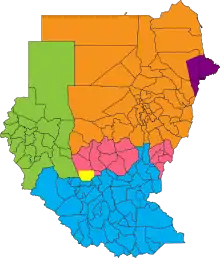States of Sudan
Below is a list of the 18 states of Sudan, organized by their original provinces during the period of Anglo-Egyptian Sudan. Arabic language versions are, as appropriate, in parentheses. Prior to 9 July 2011, the Republic of Sudan was composed of 25 states.[1] The ten southern states now form part of the independent country of South Sudan. Two additional states were created in 2012 within the Darfur region, and one in 2013 in Kordofan, bringing the total to 18.
 |
|---|
| This article is part of a series on the politics and government of Sudan |
|
|
| States of Sudan الولايات السودانية (Arabic) | |
|---|---|
 | |
| Category | Federated state |
| Location | Republic of the Sudan |
| Number | 18 States |
| Populations | 832,112 (Blue Nile) – 5,274,371 (Khartoum) |
| Areas | 22,140 km2 (8,549 sq mi) (Khartoum) – 348,770 km2 (134,659 sq mi) (Northern) |
| Government | State government |
| Subdivisions | Districts |
Administrative Subdivisions of the Republic of Sudan
The Republic of Sudan is divided into 18 states and one area with special administrative status:
States
- Khartoum (ولاية خرطوم Wilāyat Ḵarṭūm)
- North Kordofan (ولاية شمال كردفان Wilāyat Šamāl Kurdufān)
- Northern (ولاية الشمالية Wilāyat aš-Šamāliyya)
- Kassala (ولاية كسّلا Wilāyat Kassalā)
- Blue Nile (ولاية النيل الأزرق Wilāyat an-Nīl al-ʾAzraq)
- North Darfur (ولاية شمال دارفور Wilāyat Šamāl Dārfūr)
- South Darfur (ولاية جنوب دارفور Wilāyat Janūb Dārfūr)
- South Kordofan (ولاية جنوب كردفان Wilāyat Janūb Kurdufān)
- Gezira (ولاية الجزيرة Wilāyat al-Jazīra)
- White Nile (ولاية النيل الأبيض Wilāyat an-Nīl al-ʾAbyaḍ)
- River Nile (ولاية نهر النيل Wilāyat Nahr an-Nīl)
- Red Sea (ولاية البحر الأحمر Wilāyat al-Baḥr al-ʾAḥmar)
- Al Qadarif (ولاية القضارف Wilāyat al-Qaḍārif)
- Sennar (ولاية سنّار Wilāyat Sinnār)
- West Darfur (ولاية غرب دارفور Wilāyat Ġarb Dārfūr)
- Central Darfur (ولاية وسط دارفور Wilāyat Wasṭ Dārfūr)
- East Darfur (ولاية شرق دارفور Wilāyat Šarq Dārfūr)
- West Kordofan (ولاية غرب كردفان Wilāyat Ġarb Kurdufān) (disestablished in 2005; reestablished in 2013)[2][3]
Areas with special administrative status
As a result of the Comprehensive Peace Agreement signed in 2005, the Abyei Area was given special administrative status and following the independence of South Sudan in 2011, is considered to be simultaneously part of both the Republic of Sudan and the Republic of South Sudan, effectively a condominium.
- Abyei Area (منطقة أبيي Minṭaqat ʾAbyī)
History

Anglo-Egyptian Sudan had eight mudiriyat, or provinces, which were ambiguous when created but became well defined by the beginning of World War II. The eight provinces were: Blue Nile, Darfur, Equatoria, Kassala, Khartoum, Kurdufan, Northern, and Upper Nile. In 1948, Bahr al Ghazal split from Equatoria.[4]
There were numerous new provinces created on 1 July 1973. North and South Darfur were created from Darfur, while Kurdufan divided into North and South Kordofan. Al Jazirah and White Nile were split off from Blue Nile. River Nile split off from Northern. Red Sea was split off from Kassala.
A further fracturing of provinces occurred in 1976. Lakes split from Bahr al Ghazal, and Jonglei split off from Upper Nile. Equatoria divided into East and Western Equatoria. There were thus eighteen provinces. In 1991, the government reorganized the administrative regions into nine federal states, matching the nine provinces that had existed from 1948 to 1973. On 14 February 1994, the government reorganized yet again, creating twenty-six wilayat (states). The majority of the wilayat were either the old provinces or administrative subregions of a province. As part of the new government structure in South Sudan in 2005, Bahr al Jabal was renamed Central Equatoria. In 2006, West Kurdufan was split and merged with North Kurdufan and South Kordofan.
In January 2012, the new states of Central Darfur and East Darfur were created in the Darfur region, bringing the total number of states to 17.[5] In July 2013, West Kurdufan was reestablished.[2][3]
In July 2013 West Kordofan state restored as it was before 2005-08-16.
The government announced the re-establishment of West Kordofan state on 2012-12-20 (source [15]). President al-Bashir issued decrees endorsing the status of the three Kordofan states and appointing governors for them on 2013-07-13 (source [16]). West Kordofan contains Abyei district, whose status is still undetermined. A referendum is supposed to be held for Abyei to choose to adhere to Sudan or South Sudan.
Since April 2019, states in Sudan have been without state governments and legislative councils.
Former states now part of South Sudan
On 9 July 2011, the ten southern states became the independent country of South Sudan. They were further divided into 86 counties.
See also
References
- "States history".
- "Western Kordofan State". Archived from the original on August 12, 2013.
- "Sudan shuffles governors of Kordofan states including ICC suspect - Sudan Tribune: Plural news and views on Sudan". www.sudantribune.com.
- "States of Sudan".
- "allAfrica.com: Sudan: President Bashir Appoints New State Governors". web.archive.org. January 15, 2012.
External links
- "States of Sudan". Statoids.
- States of Sudan. Archived April 17, 2011, at the Wayback Machine
- 2008 Census Results, Central Bureau of Statistics